Mastering Wind Speed for Kiteboarding Success
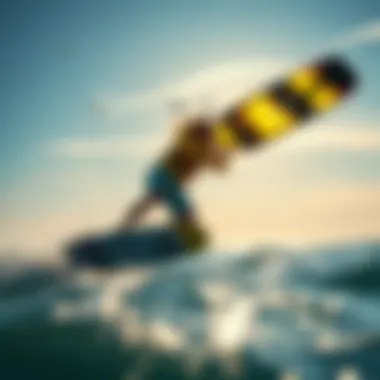
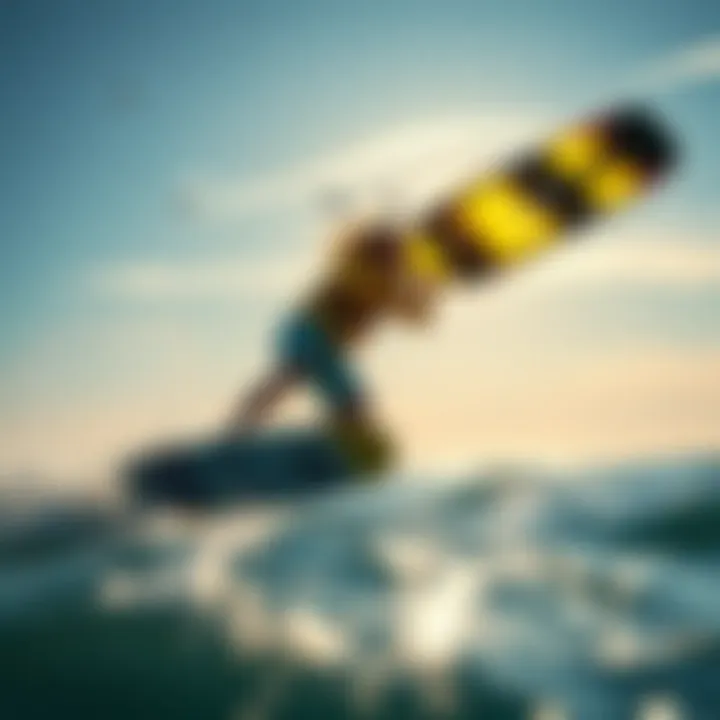
Intro
Kiteboarding presents an exhilarating fusion of wind, water, and skill, drawing enthusiasts from all walks of life. The very essence of this thrilling sport hinges on one critical element: wind speed. Understanding how to accurately assess wind conditions is vital for both safety and performance on the water. This guide will shed light on the various methods to measure wind speed, practical tips for interpreting conditions, and the equipment that enables kiteboarders to thrive in this ever-changing environment.
Gear and Equipment
To navigate the winds effectively while kiteboarding, you need more than just a kite and board. Your gear serves as your lifeline in countless conditions, influenced heavily by wind speed. Choosing the right equipment will not only enhance your performance but also bolster your safety.
Essential Kiteboarding Gear for Beginners
For those just dipping their toes into kiteboarding waters, selecting beginner-friendly gear is paramount. A decent-sized kite that corresponds to your weight and the typical wind conditions of your local spot is a good starting point.
While this can vary greatly, common recommendations for beginners include:
- A beginner-friendly kite in the 9-12m range, depending on your weight.
- A reasonably sized board, often around 130-140 cm, which provides stability and ease of control.
- A reliable harness, which should offer comfort and support.
- Safety devices such as a quick-release mechanism and those often overlooked, like a helmet or buoyancy vest, come highly recommended to guard against mishaps.
Advanced Equipment for Experienced Riders
Once you've cut your teeth and gained some confidence on your board, it might be time to consider upgrading your gear. Advanced kiteboarders often seek out equipment that offers enhanced performance and adaptability. Here’s what you might look for:
- Performance kites: These kites typically have a sleek design to better harness wind power for speed and jumping.
- A specialized board crafted for your particular style—freestyle, free-ride, or even wave riding.
- Adjustments to your harness and lines that allow quicker response to varying wind speeds, lending to a seamless ride during gusty conditions.
Techniques and Tips
Proper assessment of wind speed isn't just about the gear—it's essential to leverage techniques and tips that can dependably guide your kiteboarding experience.
Safety Practices for Kiteboarding
When it comes to kiteboarding, safety can never be overstated. All the gear in the world won't help if you're out there unprepared, relying on guesswork regarding wind conditions. To enhance safety:
- Always check local weather and wind reports before heading to the water. Websites like Windy can be invaluable for real-time updates.
- Always have a buddy with you. Partnering up can provide an extra pair of eyes and hands in case something goes awry.
- Familiarize yourself with emergency techniques. Know how to disconnect your lines quickly and how to perform a self-rescue.
Training Techniques to Improve Your Skills
Building your skills in assessing wind conditions takes time. Here are some methods to hone this crucial ability:
- Spend time learning to read the environment; observe how wind interacts with the water and any local obstacles. Choppy waters or gusty winds can be signs of tricky conditions.
- Practice using wind meters. Devices such as an anemometer can help you develop a tangible sense of wind speed and conditions.
- Regularly revise your personal performance by journaling your rides. Track wind conditions, your reactions, and performance outcomes to learn from each experience.
"Knowing the wind means knowing when to fly high and when to hug the shore."
Equipped with this information, you're better prepared to chase the winds.
The Importance of Wind Speed in Kiteboarding
Understanding wind speed is not just a technical aspect of kiteboarding—it's the very essence of the sport. The wind serves as a dynamic force, propelling the kite and, consequently, the rider across the water. The connection between a kiteboarder and wind is akin to a dance; when both move in harmony, the result is exhilarating and graceful.
The performance of a kiteboarder hinges significantly on wind speed. Too little wind, and the kite might barely catch the air, resulting in sluggish movements and frustration. On the other hand, excessive wind can transform a fun outing into a challenging and unsafe experience. Therefore, knowing how to assess wind speed is paramount for both performance and safety, making it a critical skill every kiteboarder must cultivate.
How Wind Affects Kiteboarding Performance
Wind speed directly impacts maneuverability and speed on the water. For example, when a kiteboarder finds themselves in strong winds, they can experience increased lift and speed, allowing for incredible jumps and tricks. However, this is a double-edged sword. The same wind velocity that excites can also overwhelm, especially for novices. The nuances of control become even more significant as wind conditions vary. Adjusting kite size and body positioning are essential strategies to handle different wind speeds effectively. Being in tune with these factors ensures not just a pleasant ride but one that's also safe.
Wind speed is commonly measured in knots. A light wind of around 5 to 10 knots might be ideal for beginners aiming to learn basic skills, while more experienced kiteboarders may thrive in conditions surpassing 15 knots, allowing them to perform advanced maneuvers.
Safety Considerations and Wind Conditions
Safety cannot be overstated when it comes to kiteboarding. With the thrill of the sport, there comes an inherent risk, especially in fluctuating wind conditions. An abrupt change in wind speed can catch many riders off guard, potentially leading to accidents.
It is crucial to stay updated on both current conditions and forecasts. A sudden gust or unexpected drop in wind can change your plans on a dime. Proper safety measures include:
- Assessing Growth and Decline: Before hitting the water, observe any shifts in the wind and learn to recognize the early signs of gustiness. Look for trees bending or choppy water, as these are often indicators of changing conditions.
- Using the Right Gear: Ensure that your equipment is appropriate for the wind conditions. Riding with a kite that’s too large in strong winds may lead to loss of control.
- Understanding the Environment: Familiarize yourself with the local weather patterns and seek expert advice from seasoned kiteboarders. Locations may have microclimates that can affect wind speed and direction unexpectedly.
"In kiteboarding, knowing the wind is half the battle; feeling it in your bones is where the mastery begins."
Measuring Wind Speed: An Overview
Measuring wind speed plays a vital role in kiteboarding, where the relation between wind dynamics and rider capability can heavily influence the overall experience on the water. The knowledge of wind speed is crucial; it not only affects performance but also safety, making it a foundational aspect for both newcomers and seasoned athletes alike. Kiteboarders must have a firm grasp of wind measurement to navigate their rides effectively, ensuring that they harness the ideal wind force without overexerting themselves or compromising safety.
Understanding the various elements of wind speed measurement can significantly benefit kiteboarders. Transversing different terrains requires different approaches and considerations, and wind speed can vary greatly based on the environment. For instance, kiteboarding on a tranquil lake may behave differently than conquering the waves off a windy coast. Hence, kiteboarders need to adapt their techniques according to both the wind speed and the nature of the water, keeping those they ride with in mind.
Notably, having an accurate read on wind speed can prevent those gut-wrenching moments where one might end up overpowered or underpowered, leading to a dismal experience on the board or, worse, injury. Novices often overlook this, while veterans are keenly aware of how wind fluctuations can impact their gear choices and riding styles.
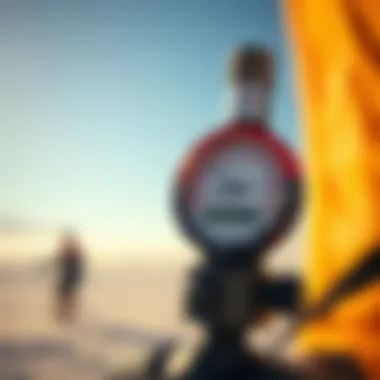
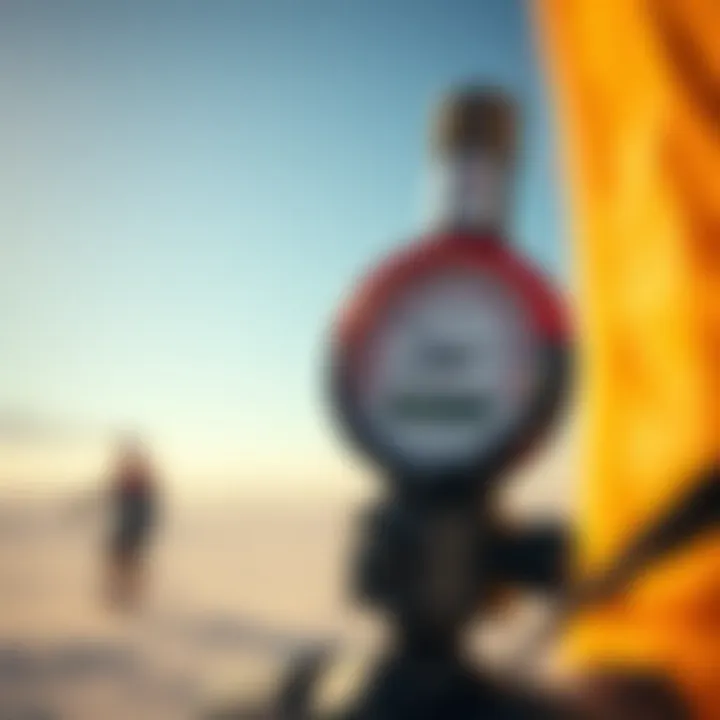
"Knowing your wind speed can mean the difference between a thrilling ride and a troublesome day on the water."
Essentially, every kiteboarding adventure should start with a careful assessment of the wind. The right measurement tools not only enhance enjoyment but also cultivate a culture of respect for the wind's intensity. Kiteboarders are encouraged to invest effort and time in learning aboutwind speed measurements, making it part of their routine so they can truly savor the adrenaline that kiteboarding brings. In the next sections, we'll dive into practical tools that can help measure wind effectively, starting with the introduction to wind measurement tools.
Foreword to Wind Measurement Tools
Wind measurement tools are crucial gears in a kiteboarder's arsenal. Simple tools like handheld anemometers to sophisticated applications on smartphones allow riders to easily assess wind speed and optimize their sessions. These instruments provide real-time data, presenting reading in units such as kilometers per hour (kph) or miles per hour (mph), which are key to understanding whether conditions are suitable for riding.
- Anemometers - These devices often come in mechanical forms or as digital gadgets that can provide precise readings with minimal fuss.
- Smartphone Applications - In today’s fast-paced world, many kiteboarders rely on apps that include not just wind forecast data but also local trends, which can be quite handy during quick sessions.
- Local Weather Stations - Many regions with kiteboarding communities often have established stations providing accurate forecasts, making it easier to plan outings without constantly relying on personal measurement tools.
Investing in a reliable wind measurement tool can mean the difference between a day of fun and one filled with frustration, so kiteboarders should regularly review their options and choose according to their needs and riding environments.
Types of Anemometers and Their Applications
Different types of anemometers serve various purposes, presenting unique features and benefits for kiteboarders. The knowledge of these can enhance one's understanding of wind measurement practices. Here's a breakdown of common types:
- Cup Anemometer: This is the classic design, consisting of three or four cups that catch the wind. It's easy to read and durable, but can sometimes be less sensitive than digital models.
- Vane Anemometer: This instrument combines a propeller with a wind vane. It’s often used when needing to determine both wind speed and direction, providing more comprehensive information to the rider.
- Digital Anemometer: With a screen that displays readings instantly, these devices are popular among kiteboarders for their accuracy and ease of use. Many models come with features that log data over time, which can aid in analyzing wind trends.
- Hot Wire Anemometers: These are less common, but highly sensitive to small changes in wind speed, often used where precision is crucial.
Each type of anemometer has its unique applications. For instance, while a cup anemometer may do just fine for casual riders, a digital model may be the go-to choice for those wanting consistent, reliable data, especially in varying wind conditions. Before heading out, knowing which instrument best fits your style can make a remarkable difference in how you interact with the wind around you.
Understanding Anemometers
Anemometers play a vital role in kiteboarding, as they provide insights into wind speed that directly influences performance and safety. With a clear understanding of the various types of anemometers, kiteboarders can make informed decisions about when and where to ride. From practical applications to the nuances of their operation, this section will delve into the significance of these devices in the kiteboarding world.
Key elements to consider about anemometers include:
- Accuracy of Readings: How precise anemometers are in measuring wind speed can make all the difference in safely engaging with kiteboarding activities.
- Ease of Use: Some models are straightforward and user-friendly, while others can be complex and require a bit of a learning curve.
- Portability: Depending on the kiteboarder's needs, compact and lightweight options may be more preferable.
Benefits of understanding anemometers include:
- Improved decision-making about kiteboarding conditions.
- Enhanced safety measures resulting from accurate wind assessments.
- Greater enjoyment through optimized performance tailored to wind conditions.
Mechanical Anemometers: How They Work
Mechanical anemometers utilize moving parts to detect and measure wind speed. These devices often consist of a set of cups or blades that spin or pivot in the wind. The speed at which these components rotate correlates with the wind's velocity. While mechanical anemometers are robust and straightforward, they typically measure wind speed through analog means, which might not be as easy to read at a glance as digital versions.
Common types include:
- Cup Anemometers: Characterized by three or four cups mounted on horizontal arms, they measure wind based on how fast the cups spin. They are reliable for various wind conditions and can function effectively over a range of speeds.
- Vane Anemometers: These units combine a rotating blade and a wind vane. The vane aligns with the wind direction, while the blade measures the speed.
While they serve well, mechanical anemometers can be less sensitive to light winds compared to their digital counterparts, making them more suitable for established wind patterns rather than subtle changes.
Digital Anemometers: Advantages and Limitations
Digital anemometers represent the evolution of wind measuring technology. They typically feature advanced sensors and display real-time measurements, providing users with instant access to crucial wind data. This immediacy can afford kiteboarders an edge, especially when conditions can shift quickly.
Some advantages of digital anemometers include:
- Higher Accuracy: Equipped with electronic sensors, they can handle a wider range of wind speeds with precision.
- Data Logging: Many digital models allow for storing past measurements, enabling users to track trends in wind speed over time.
- User-Friendly Interfaces: Clear digital displays make it easy to read the data.
However, they come with limitations too. Battery life can be a concern, particularly on longer sessions, as reliance on electronic components may lead to failure if not properly charged or maintained. Additionally, digital anemometers can be generally more expensive compared to mechanical models, which might deter some budget-conscious kiteboarders.
"Knowing the wind speed and direction is like having a map and compass; it helps you navigate the course of your kiteboarding adventures without unnecessary hiccups."
In summary, both mechanical and digital anemometers have distinct roles in the kiteboarding community. By understanding these devices and their operating principles, kiteboarders can ensure they're prepared to tackle the ever-changing conditions of the water.
Alternative Methods for Checking Wind Speed
Wind speed is the lifeblood of kiteboarding. Without an accurate understanding of wind conditions, the thrill of riding can quickly turn into a precarious situation. Aside from traditional anemometers, kiteboarders now have various alternative methods to gauging wind speed. These methods offer flexibility and can often be utilized in real-time, allowing riders to stay updated throughout their session. Growing reliance on technology also means we have handy resources right in our pockets—smartphones—making checks easier than ever.
Using Smartphone Apps for Wind Assessment
Smartphone applications have revolutionized the way many kiteboarders assess wind conditions. With just a touch of a finger, one can tap into a world of data. Applications like Windy and KiteLink provide various features that cater specifically to water sports enthusiasts.
Benefits of these apps include:
- Real-Time Data: Many apps pull real-time information from weather stations local to your riding area.
- Interactive Maps: Visualization tools can show wind patterns, speed, and even turbulence conditions visually, making it easier to understand what’s happening in the skies.
- Notifications: Some apps allow users to set alerts for specific wind speeds, ensuring that they don’t miss ideal kiteboarding conditions.
However, users must remember that while these apps can be extremely helpful, they are not infallible. The accuracy can sometimes lag, especially in rapidly changing weather patterns. It’s important to cross-reference the data with local wind observations, if available, before hitting the water.
Wind Forecast Websites and Their Relevance
In addition to smartphone applications, websites focused on wind forecasts play a crucial role in kiteboarders' planning. Websites like WindFinder and NOAA provide comprehensive data not just about current conditions but forecasts for days ahead.
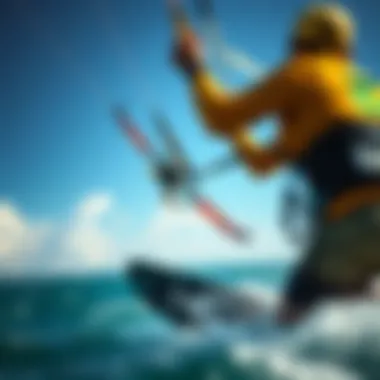
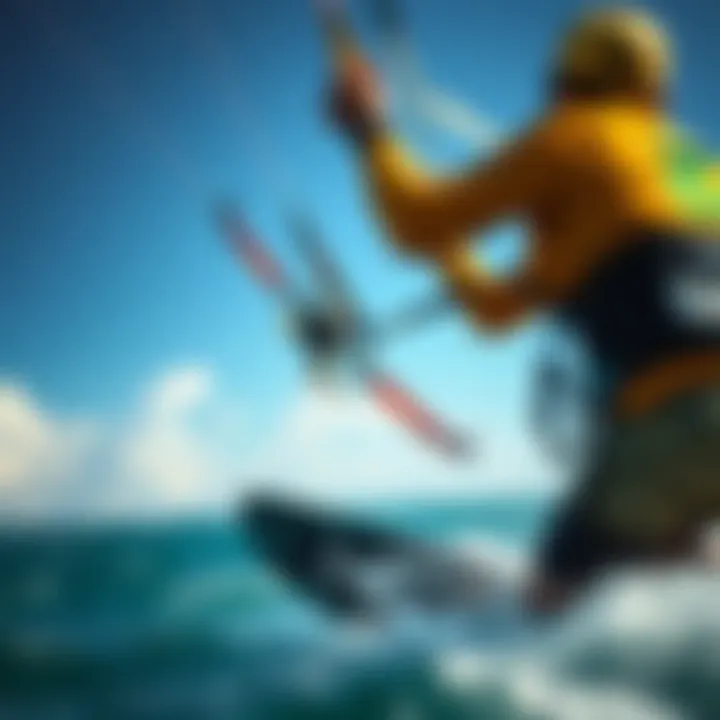
Here’s why kiteboarders find these resources indispensable:
- Forecasting Tools: They often provide predictions that can help plan future trips or sessions around optimal weather conditions.
- Detailed Observations: Alongside wind speed, users can find information regarding gusts, direction, temperature, and even tide information which is invaluable for pre-ride analysis.
- Community Insights: Many sites also have forums or community discussions where riders share their experiences and insights about local conditions, adding a personal touch to the data available.
It’s essential to keep in mind that while these sites provide a broader scope of wind conditions, frequent updates are necessary. Changes can occur rapidly, and having the most accurate and up-to-date information can make all the difference in ensuring a safe ride.
In summary, the tools for checking wind speed have expanded greatly. Smartphone apps and websites provide dynamic and accessible resources for kiteboarders. Being aware of the advantages and limitations associated with each is key to making the best use of them. By leveraging these alternative methods, kiteboarders can navigate wind conditions like seasoned pros.
Interpreting Wind Speed Readings
Interpreting wind speed readings is a vital skill for anyone serious about kiteboarding. Kiteboarding performance hinges not just on the strength of the wind but also on correctly understanding what those wind speed readings mean. A solid grasp of how to interpret these readings can make a world of difference between an exhilarating ride and a dangerous experience out on the water.
For kiteboarders, understanding wind speed is essential. It involves knowing the units of measurement, being able to assess the wind speed ranges suitable for various skill levels, and recognizing the practical implications of those readings on their performance and safety. Mistaking a mild breeze for a strong wind can lead to unfortunate consequences, not only for the rider but also for others in proximity.
"Knowing how to read the wind is as vital as knowing how to ride. It’s an art and a science, and mastering it can significantly enhance your kiteboarding experience."
Understanding Units of Measurement
When it comes to measuring wind speed, familiarity with the units involved is crucial. Wind speed is typically reported in miles per hour (mph) or kilometers per hour (km/h). However, you might also encounter units like knots (nautical miles per hour). Each of these units has its context and audience; for instance, sailors often use knots while most land-bound services lean toward mph or km/h.
Understanding these basics helps kiteboarders quickly assess whether the wind conditions are favorable for their specific skill level. For example:
- Light Wind: Generally considered to be under 12 mph (or about 10 knots), where movements may be limited, but it may be great for beginners.
- Moderate Wind: Ranges between 12-20 mph (about 10-17.5 knots). Good for most riders at varying skill levels.
- Strong Wind: Anything above 20 mph (or 17.5 knots) can be challenging; advanced skills are usually required here.
This differentiation helps kiteboarders make informed decisions about whether to hit the water or stay ashore.
Assessing Wind Speed Ranges for Kiteboarding
Once you have a handle on wind measurement units, the next step is understanding how those readings translate into kiteboarding conditions. Different wind speeds cater to diverse skill sets and kite sizes, meaning assessing the wind speed correctly is crucial for safety and enjoyment alike.
Beginner kiteboarders often favor wind speeds in the 8-15 mph range. This allows for more control while learning to master the basics. Conversely, intermediate riders can handle slightly stronger winds, approximately 15-20 mph, as their techniques have developed but they still need to be cautious.
Experts, on the other hand, usually thrive in intense conditions, from 20 mph and beyond, where they can showcase their skills in aerial maneuvers and complex tricks. Each rider should always account for their personal limits, and weather conditions can change fast, making it essential to be prepared.
To summarize, here’s a quick guideline for kiteboarding wind speed assessment:
- Light Winds (under 12 mph): Ideal for beginners.
- Moderate Winds (12-20 mph): Suitable for beginner to intermediate boarders.
- Strong Winds (20+ mph): Best for experienced riders, risky for all others.
Stay informed about wind conditions by checking reliable sources like NWS or local meteorological services.
Knowing how to interpret wind speed readings can lead to not only better kiteboarding sessions but also heightened safety and enjoyment.
Wind Direction and Its Impact
The direction from which the wind blows is a crucial factor that kiteboarders must account for in order to ensure an enjoyable and safe experience on the water. Understanding wind direction not only affects the performance of the kite but also plays a significant role in rider safety and efficiency. Kiteboarding can be an exhilarating activity, but without proper awareness of wind direction, it can quickly become challenging or even dangerous.
How Wind Direction Influences Kite Control
Kite control is primarily determined by how the wind interacts with the kite's surface and shape. Depending on wind direction, the kite can be manipulated to achieve optimal lift, speed, and agility. Here are some key points to remember:
- Crosswind Flight: When riding in crosswinds, the kite has the advantage of additional speed and increased maneuverability. This wind position provides a balance between lift and pull, allowing riders to perform various tricks and maneuvers.
- Upwind Performance: When the wind is coming from directly in front, i.e., upwind, a kite can still generate lift but requires more skill. Riders must lean back into the kite to maintain speed and control as they navigate against the wind. Proper technique is essential to avoid stalling.
- Downwind Riding: If the wind blows from behind, or downwind, riders experience a powerful push from the kite, which can lead to high speeds. However, this can make controlling the kite more difficult, especially if the rider isn't accustomed to such velocities. In this case, it becomes essential to steer the kite actively to maintain stability.
In all these cases, adjustments to body position and kite angle can greatly influence how effectively the kite responds to varying wind conditions. Understanding these dynamics can keep you from facing trouble, although you may feel you're flying high at times!
Determining Optimal Wind Directions for Riding
Determining the best wind direction isn’t just about feeling the breeze on your face. It involves assessing various environmental elements that contribute to a safer and more enjoyable kiteboarding session. Here’s what to consider:
- Local Wind Patterns: Every kiteboarding location has distinct wind characteristics. Some spots may have consistent thermal winds in the afternoon while others can be highly variable due to geographical features. Knowing these patterns helps riders plan their sessions better.
- Safety Zones: It's vital to identify and choose areas that provide safe conditions for specific wind directions. Open water is generally preferable; avoiding rocky shores or crowded beaches reduces risks.
- Current Wind Forecasts: Wind direction can change throughout the day. Keeping an eye on weather apps and websites, such as Weather.com or Windy, can provide real-time updates that can inform any potential shifts that may impact your riding.
Always assess wind direction before launching your kite. The winds can shift unexpectedly, and what seems like an ideal day may turn out to be less than favorable.
Familiarity with how wind direction affects your riding can lead to numerous benefits. Not only will you optimize your sessions, but you will also grow more confident in making quick decisions while on the water. Ultimately, understanding how to master wind direction could be the difference between a good ride and a great one.
Adapting to Changing Wind Conditions
In kiteboarding, the wind is a double-edged sword; it can either propel you to thrilling heights or send you crashing down. Being able to adapt to changing wind conditions is crucial for enhancing both your performance and safety on the water. Wind doesn’t just come in a single, steady stream; it swirls, shifts, and sometimes acts downright unpredictable.
Recognizing Signs of Changing Winds
The first key to adapting is to be attuned to the signs of shifting winds. Experienced kiteboarders often develop an intuitive sense of these changes. Here are some common indicators to look for:
- Visual Cues: Watch the water surface. Ripples and small waves might signal gusts or shifts. If you notice patches of water that look calmer or "danced" upon by little white caps, pay close attention.
- Cloud Patterns: Those lovely cumulus clouds you see could indicate changing winds. Low cloud cover can mean a wind shift is on its way. Similarly, if the cloud formations start to darken, you might want to reassess your plans for riding.
- Temperature Changes: A sudden drop or rise in temperature can indicate a front moving in, which can drastically change wind conditions.
- Wind Sound: Listen closely; the sound of the wind changes its tone momentarily before shifts occur. It might be a barely perceptible change, but trained ears can catch it.


Recognizing these signs sooner rather than later can keep you ahead of the game, allowing you to adjust your strategy effectively.
Adjusting Gear Based on Wind Variability
Once you've detected changing wind conditions, the next step is adapting your gear accordingly. Having the right setup could mean the difference between a fun day on the water and an unexpected trip to shore.
- Kite Size: Wind strength directly correlates to the size of the kite you should use. In light winds, a larger kite helps catch more air, while in stronger winds, a smaller kite keeps you stable. Be prepared to adjust.
- Line Length: Longer lines can provide more power in light winds, while shorter lines might give you more control in gusty conditions. Switching out your lines could be a smart move when the winds begin to shift.
- Safety Gear: Always have your safety gear tuned to the expected conditions. In higher winds, ensure that your harness and safety release are in optimal shape, ready for any sudden situations that might arise.
- Technique Adjustments: Great kiteboarders sometimes change their technique based on wind conditions. Leaning in more during gusts or keeping a low profile in strong winds might be necessary strategies to remain stable.
In summary, being vigilant about changing wind conditions not only enhances your performance but ensures that your time on the water remains safe and enjoyable. Taking the time to recognize signs and adjust your gear accordingly can truly make a world of difference.
"Kiteboarding is less about conquering the wind and more about flowing with it."
Adaptability sets great kiteboarders apart from the rest. By being aware of your environment and the nuances of wind behavior, you can make the most of your sessions and enjoy the ride much more.
Practical Tips for Kiteboarders
Kiteboarding is a sport that thrives on the whims of the wind. Whether you're a seasoned pro or just starting out, having practical tips in your back pocket can make a world of difference. This section provides essential strategies to ensure you stay safe while optimizing your riding experience. Knowing how to assess wind conditions accurately can boost both your performance and enjoyment on the water. Let's dive into those best practices and see how you can build a strong wind awareness routine.
Best Practices for Checking Wind Speed Before Riding
Before you even step foot on your board, it's vital to check the wind speed. Ignoring this step can lead to unfortunate incidents, or at the very least, an unsatisfying session. Here are some expert recommendations on how to go about it:
- Use Reliable Measurement Tools: Anemometers are a kiteboarder's best friend. Consider using handheld or even smartphone apps that can provide real-time wind speed readings. Apps like Windy or KWind are especially helpful.
- Observe the Environment: Sometimes, technology may fail you, so look at the surroundings. Check how trees sway, flags flapping, or even how the water surface behaves. This will give you an idea of the wind's intensity without relying solely on gadgets.
- Engage with the Local Kiteboarding Community: Often, local riders have a wealth of experience and insights about the wind conditions at specific spots. Joining forums or social media groups can keep you in the loop.
- Be Aware of Dynamic Weather Patterns: Winds can change rapidly due to local weather fronts. Keep an eye on the sky. If clouds are starting to gather or windsocks begin to dance erratically, it might be time to reconsider heading out.
Remember, safety first. If the wind feels gusty or above your comfort zone, taking a rain check is not only wise but could save your gear and even your skin.
Building a Wind Awareness Routine
Developing a wind awareness routine is like having a secret weapon in kiteboarding. This habit can enhance your decision-making process and keep you in tune with wind dynamics. Here are some straightforward steps to consider:
- Start with Daily Checks: Begin each kiteboarding day with a routine check of local wind reports and conditions. Websites and apps, such as Meteomatics, can offer detailed forecasts.
- Create a Personal Wind Log: Keeping a record of wind conditions during your sessions helps to identify patterns. Note the time, date, speed, and how it felt during your ride. Over time, you’ll refine your understanding of how wind impacts your performance.
- Wind Direction Practice: Spend some time understanding how different wind directions affect your ride. You might find that a cross-shore breeze feels completely different from an offshore wind.
- Talk to Others: Don’t be shy. Chat with more experienced kiteboarders about wind considerations. Each conversation can reveal tips or tricks that might not be on your radar yet.
Case Studies: Wind Speed in Action
Understanding the practical implications of wind speed is crucial in kiteboarding. By looking at real-life examples, we can appreciate not just the theoretical aspects but also the on-the-ground realities that kiteboarders face in different wind conditions. This section sheds light on how accurate wind checks can lead to successful sessions while emphasizing the importance of learning from past mistakes in evaluating wind conditions.
Successful Kiteboarding Sessions with Accurate Wind Checks
In kiteboarding, having a good read on the wind can make the difference between an exhilarating ride and a risky situation. For instance, consider the experience of a group of kiteboarders who ventured out on a sunny afternoon at Cape Hatteras. They consulted a local wind report and a digital anemometer, confirming readings of around 15 to 18 knots. This information prompted them to use their medium-sized kites, which suited the conditions perfectly. Their session was marked by smooth glides and impressive jumps; everyone came back with a smile, recalling the thrill of riding atop the water with the perfect amount of power from their kite.
The use of technology in this scenario cannot be overstated. Relying on tools designed for accurately measuring wind speed allowed the group to make informed decisions about which equipment to use and how to approach their rides. Moreover, their success highlighted a communal spirit: experienced kiteboarders shared their insights, proving that knowledge can be as important as skill.
- Lesson Learned: Accurate wind checks boost confidence and performance.
- Tool Usage: Digital anemometers add reliability to wind assessments.
"Accurate wind measurements can turn an average day into an unforgettable adventure on the water."
Learning from Mistaken Wind Evaluations
On the flip side, wind evaluation can sometimes lead us down the wrong path. A key example can be drawn from an event at a popular kiteboarding destination on the Florida coast. A group of enthusiastic kiteboarders misread the wind conditions, mistaking a light breeze for something more robust. They relied solely on visual cues, neglecting to check their portable wind meter. As a result, kite sizes chosen were far too large for the actual wind speed, which clocked in at a mere 8 knots.
The outcome was predictable: frustrated kiteboarders found themselves struggling against the wind, unable to catch adequate lift. Some faced the annoyance of tangled lines or even minor accidents when trying to control their oversized kites.
Key takeaways from this mishap include:
- Risk of Overconfidence: Trusting visual assessments can lead to poor decisions.
- Importance of Verification: Combining tools with observational skills is vital.
In the end, this incident served as a valuable reminder: wind in kiteboarding is no trivial matter. Kiteboarders are encouraged to rate the wind conditions using all means available, integrating both technology and experience to prevent mishaps and maximize their enjoyment.
Whether telling the tales of triumphant rides or the lessons gleaned from mistakes, these case studies illustrate the undeniable impact of understanding wind speed in kiteboarding. Recognizing both successful sessions and mistakes shapes a kiteboarder's skill set, making them better prepared for future outings.
Ending: Mastering Wind Speed Awareness
Navigating the winds of kiteboarding isn’t just a thrilling endeavor; it's a calculated dance with nature that demands respect and knowledge. Understanding wind speed is vital, as it serves as the cornerstone for both safety and performance on the water. Kiteboarding is marked by rapid shifts in conditions, and a keen awareness of wind speed empowers riders to adapt and stay in control, ensuring their experience is not only enjoyable but safe.
Final Thoughts on Wind Speed Measurement
Effective wind speed measurement is essential for every kiteboarder, from the rookie to the seasoned pro. Various methods, from using anemometers to smartphone apps, provide valuable data on the conditions ahead. Riders must distill this information into actionable insights.
- Utilize Proper Equipment: Invest in quality wind measurement tools to ensure you’re reading the winds accurately. Remember, a reliable anemometer or a trusted app can save you from misjudged outings.
- Know Your Limits: Familiarize yourself with what wind speeds work best with your skill level and equipment. It’s not just about hitting the water when the wind blows; it’s knowing which winds are right for you.
- Regular Updates: Conditions can flip on a dime—get into the habit of checking wind forecasts regularly before heading out, as conditions can change significantly in a matter of minutes.
"Wind doesn’t have a game plan; it changes direction as fast as a cat on a hot tin roof. Stay sharp and read the signs!"
Developing a comfortable relationship with wind speed measurement can lead to rewarding kiteboarding experiences. Engaging with the process contributes to your overall growth as a kiteboarder, honing your intuition and skill.
Encouraging Continued Learning and Adaptability
In this sport, complacency can be a downfall. Kiteboarding thrives on continuous learning—each outing offers new insights into wind behavior and how to respond. Here’s how to keep that learning curve sharp:
- Attend Workshops: Join local kiteboarding groups or workshops. These environments can forge connections with experienced riders and provide hands-on learning about navigating wind patterns.
- Document Your Adventures: Keep a personal log of your kiteboarding sessions. Capture the wind conditions, your gear choices, and the outcomes. Over time, patterns will emerge, and you’ll develop a sharper eye for what to expect.
- Stay Informed: Be proactive in seeking new information. Online communities, articles, and educational resources about kiteboarding can keep your knowledge fresh. Websites like Kiteboarding.com and forums on reddit.com can be great starting points.



